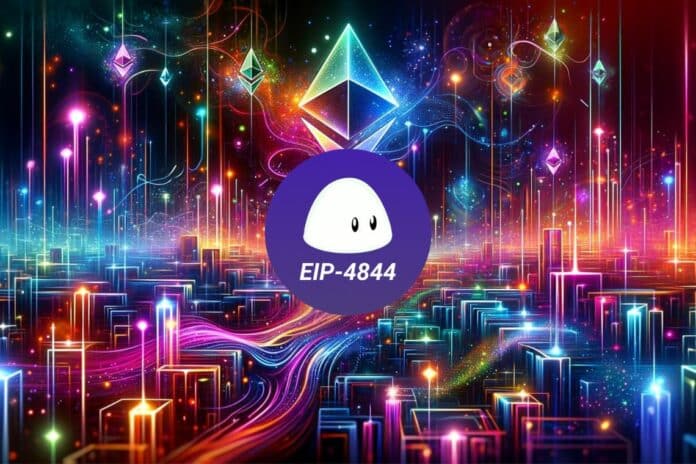On Wednesday, March 13th, the Dencun update went live on the Ethereum blockchain, officially implementing the “blob” data storage space on all layer-2 of the cryptographic network.
The Blobs are nothing but a scalability solution, introduced with the proposal “Proto-DankSharding” (EIP-4844) that anticipates the transition to full chain sharding.
Below we see how this innovative element of Ethereum works and what advantages it brings.
Summary
The Dencun update of Ethereum introduces blobs for the first time in L2 transactions
With the arrival of the Ethereum hard fork on Ethereum clients, a new cryptographic element known as “blob” has been introduced, whose role is of fundamental importance for the underlying blockchain to solve its scalability limits.
The blobs, introduced thanks to the integration of EIP-4844 Proto-DankSharding, can be summarized as block spaces for data storage that, replacing traditional pointers to call data, work efficiently requiring less work from Ethereum’s decentralized infrastructure.
The ultimate goal of blobs is to reduce the commission costs of the layer-2 of the network in question: how do they achieve this goal at a technical level?
Let’s start from the assumption that the starting idea with which these blobs were conceived in EIP-4844 is to create a new storage section that Ethereum’s EVM is not able to execute.
Originally, before Dencun, the data storage phase at the execution level was permanent. This means that if a transaction was published, once stored by all nodes, it would remain permanently visible on the chain.
The blobs solve this “immutability problem”, which in itself does not create problems in terms of consent but limits the performance of the chain, creating a type of transaction (blob-carrying-transaction) whose data is not accessible to the Ethereum Virtual Machine and are automatically deleted after about 18 days.
By doing this, a slimmer storage space is created, as now the nodes that handle the validation of the blocks no longer need to validate every connection between L2 and the main Ethereum network, but only need to verify the compliance of the reference to the blob itself, which contains information about externally operated transactions.
All this translates into less work for the active components of the cryptographic infrastructure, which can save energy (and therefore gas from the network) and use it for other noble purposes, effectively contributing to make Ethereum more scalable.
Regarding this historic integration, Polygon Labs’ VP of Product, David Silverman, stated that blobs, being temporarily stored, are drastically more cost-effective for rollups and provide the same security guarantees.
Several other key members of the community, as well as all the prominent projects built on Ethereum, in recent days have shared their excitement for an update that significantly improves the chain, making it more competitive for the future market.
Advantages of using blobs compared to call data
Compared to the classic call data betting mechanism, where transactions from layer-2 to Ethereum or vice versa are stored for life by the EVM, the use of blobs brings a substantial advantage.
As mentioned in the previous paragraph, the use of a storage space of this type, whose data is periodically deleted, makes Ethereum rollup fees significantly cheaper than before.
Optimistic rollup like Arbitrum, Optimism and Base, but also several Zk rollup like Starknet and zkSync, have already noticed the difference from the Dencun upgrade, with fees for sending funds or for swaps that have dropped significantly, up to even 100 times the initial values.
In this context it is important to underline that all layer-2 will benefit from the introduction of blobs, but it will take some time before the integration reflects the reduction of network costs.
Indicatively we will see the effects of Dencun in the next 2 weeks, when all network operators of the L2 will have updated their clients and added the “blob transactions” to their infrastructures.
Furthermore, we must emphasize that currently blocks on Ethereum can contain up to a maximum of 16 blobs, with a current value of 8 blobs at the time of writing this article.
The more blobs are used in a block, that is, the more entities require the service, the more fees on the same layer-2 could undergo small increases.
Even considering the maximum use of 16 blobs per block, the fees would still be lower than the initial ones, but it is important to consider that a fee market will be formed in this sense similar to those present on the canonical Ethereum blocks.
We are still at the beginning of the long journey that will lead us to make Ethereum scalable once and for all, as much as a centralized payment infrastructure like for example Visa.
The debut of blobs opens the doors to a new era, made of economical solutions on layer-2 that will lead in the not too distant future to the contamination of the same practices on the main network.
Everyone is excited right now about the groundbreaking development in the blockchain world: even Hayen Adams, the renowned founder of the decentralized exchange protocol Uniswap, has shared his excitement on X showcasing gas fees on Optimism lower than 0.01 dollars.




